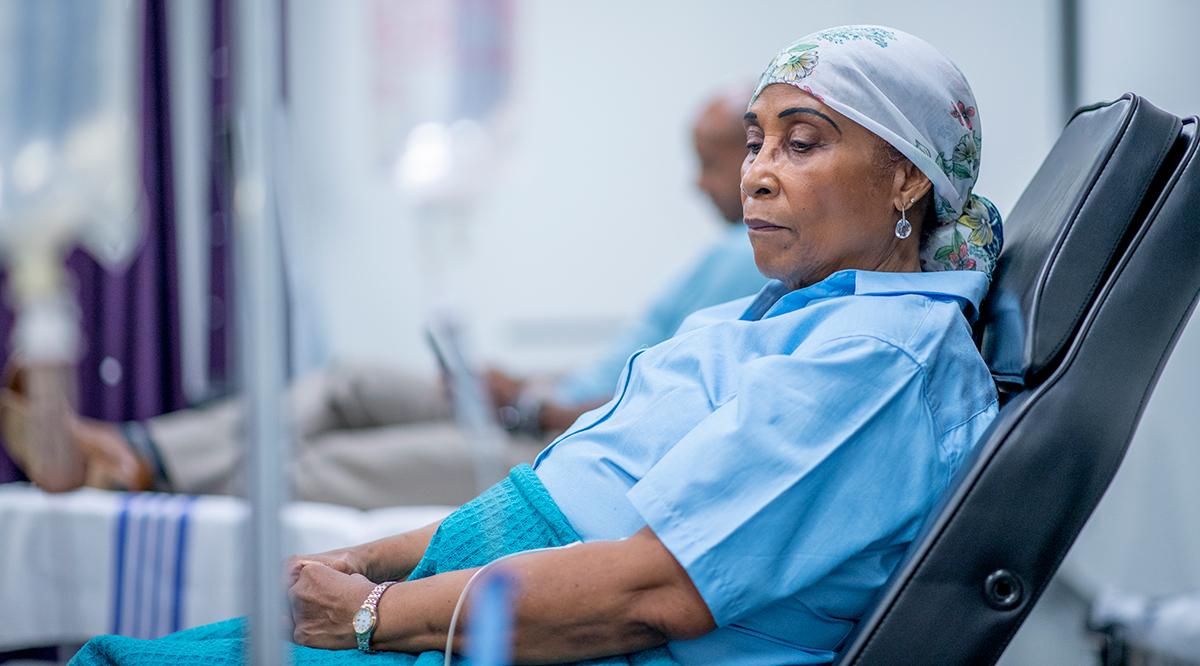Over the past 30 years, overall cancer mortality rates in the United States have declined by nearly 30%. This is thanks largely to efforts by researchers, clinicians, and community advocates to increase awareness of preventive measures, improve access to screenings to catch cancers at earlier stages, and develop new and more effective treatments.
However, there’s a large caveat to this good news.
Despite the overall declines in cancer deaths, significant disparities exist, including by socioeconomic status and region, but most glaringly by race, according to a report from the American Cancer Society.
The report found that Black people are less likely than people of other races to be diagnosed at an early stage and are also more likely to die, and that Black women have a 12% higher overall cancer death rate than White women despite having an 8% lower incidence rate.
“When we looked into trends for four major cancer types — lung, colorectal, breast, and prostate — we saw declines in all or most congressional districts,” says Farhad Islami, MD, PhD, senior scientific director of cancer disparity research at the American Cancer Society. “We also found a great disparity in the rate of declines … showing we need to do more to reduce cancer death rates.”
For example, though Black and White women over the age of 50 get breast cancer at similar rates, Black women have a 40% higher mortality rate, explains Adetunji Toriola, MD, PhD, a professor at Washington University School of Medicine in St. Louis (WUSTL) and a breast cancer researcher at the Siteman Cancer Center.
While some researchers and clinicians have been sounding the alarm about health inequities for decades, institutional interest and investment has increased in recent years, particularly after the COVID-19 pandemic put a spotlight on racial disparities and the murder of George Floyd prompted a global racial reckoning.
“It’s our duty at academic medical centers to do all we can to begin to fully address these disparities by devoting more resources to research questions that will help reduce disparities,” says Toriola.
Underlying causes
The reasons behind cancer disparities are multifaceted, ranging from genetics to insurance coverage, but research suggests that there is a common thread of racial discrimination.
Though genetics can impact an individual’s cancer risk, this only accounts for a tiny portion of mortality for Black cancer patients, according to a 2022 report from the American Cancer Society.
Black people are more likely to have lower incomes than White people; Hispanic people and Black people have higher uninsured rates than White people; and Black and Hispanic people are more likely to live in environments that contribute to cancer risk, such as food deserts, highly polluted areas, and places where smoking is more common.
Compounding these social determinants are experiences of racism in health care settings.
“A lot of people say, ‘Oh, it’s all the social determinants of health. It’s all money and that’s the problem. It has nothing to do with racism,’” says Samuel Cykert, MD, a professor at the University of North Carolina (UNC) School of Medicine in Chapel Hill and a researcher focused on health disparities. “Well, sorry, but that’s not the case. We’ve done lots of studies that show that even when you control for income, insurance, [and] education, that there’s still a racial difference.”
In 1999, Cykert read a study led by Peter Bach, MD, and published in the New England Journal of Medicine that found that Black people diagnosed with a lung cancer that could possibly be treated surgically were less likely than White people to receive the operation. Black patients also had a lower five-year survival rate than their White counterparts, although Black patients who received the surgery had similar survival rates to their White counterparts.
“That made me scratch my head because if you didn’t go to surgery, you were dead. So why should there be that big of a gap?” Cykert recalls. “[I thought] this doesn’t make a lot of sense to me.”
The revelation inspired him to study health disparities and, in 2003, join the Greensboro Health Disparities Collaborative, a North Carolina-based community group dedicated to solving unequal treatment in health care. This partnership eventually led to the creation of a multi-year cancer intervention project called Accountability for Cancer Care through Undoing Racism and Equity (ACCURE), using community input to design an intervention to improve treatment for everyone.
For six years, the ACCURE project worked on improving cancer outcomes by connecting cancer patients with a navigator to help remove social barriers to accessing treatment, by tracking progress and potential issues in real time utilizing electronic records, and by educating clinicians on implicit bias and holding them accountable for their patients’ outcomes.
“We did quality improvement [QI] and met with the care teams quarterly and educated them about their numbers. In normal quality improvement, you just say X percent of patients have met this measure. But we conducted a race-specific QI. So in other words, we made sure that physicians knew this is how your White patients are doing and this is how your Black patients are doing. So they understood there was actually a difference and they were challenged to think about barriers that created that difference,” Cykert explains. “We’d also mentioned things like, ‘Oh, by the way, this is what implicit bias is. By the way, this is what clinical inertia is.’ And so people became more aware of those opportunities as we fed them the data.”
The results were to nearly eliminate racial disparities in treatment and outcomes for early-stage breast and lung cancers at the clinical sites. Treatment completion rates went from 87.3% to 89.5% for White patients and from 79.8% to 88.4% for Black patients.
Though the results of the ACCURE project were published in 2019, health systems have been slow to adopt the method, Cykert says. Some systems in North Carolina, including UNC, are in the beginning stages of implementing the program. People from several other academic institutions have also reached out to Cykert to discuss how they can implement similar programs at their own institutions, so he is hopeful there will be more movement in the coming years.
“The most important messages are that involving communities and getting their experience with barriers is really important. And the second thing is that the ACCURE intervention works,” Cykert says. “And then the last thing is, it has to be a systematic approach. It’s not a matter of working with one patient and saying, ‘Oh, gee, you know, the problem is you. You’re not making the right decisions.’ You have to build a system that approaches everyone.”
Representation in cancer care and research
One essential part to rebuilding the health care system to address racial disparities in care is to reassess representation within the system, according to Toriola.
“[We must be] fostering greater [diversity, equity, and inclusion] within the workforce so the treating faculty at many of these institutions would also resemble the patient populations that they treat,” he says.
Black people are underrepresented in cancer research and oncology, despite being overrepresented in cancer incidence and mortality.
That fact was glaring to Sigourney Bonner, a PhD student and cancer researcher at the University of Cambridge in the United Kingdom. In 2020, after seven years working in cancer research, Bonner had never met a Black woman with a PhD until she started her own course of study. Because so few of the Black people in her social circle knew anyone else with whom they felt comfortable and who worked in cancer research, Bonner found herself fielding any and all cancer questions.
“‘My aunt/cousin/friend [has] been diagnosed, what should I do?’ And I would think, ‘I work on a rare children’s brain tumor, I don’t know what to tell you about your metastatic prostate cancer,’” Bonner says. “But I wanted to help in the best way I could.”
Bonner also found the lack of representation in her field challenging. That year, she met Henry J. Henderson III, PhD, who was then a postdoctoral student at Vanderbilt University School of Medicine in Nashville. Together they started Black in Cancer, an organization dedicated to connecting Black people working in the cancer space and promoting visibility and representation in the field.
In the three years since its inception, Black in Cancer has partnered with advocacy groups to increase cancer prevention and screening awareness in Black communities, held conferences for Black people working in cancer research and care, and started mentorship and pathway programs to bolster future representation of Black people in the field.
“We think that it’s really important that the research space reflects the clinical space because we think that that’s how we progress,” Bonner says. “We have diverse thought when we have people thinking about their own communities and how we are taking care of not just one section of society, but all.”
While most of these initiatives are organized by volunteers, they also require funding, Bonner adds. This means that governments and academic institutions that are serious about reducing cancer disparities in outcomes and increasing diversity of the cancer workforce will need to fund research, interventions, and pathway programs.
As part of his resurrection of the Cancer Moonshot, a national initiative to reduce the impact of cancer, President Joe Biden has made addressing inequities a priority and has awarded millions of dollars in grants for prevention and screening for medically underserved communities and for research into cancer disparities. WUSTL, for example, has been awarded $17 million through the Cancer Moonshot to address disparities in cancer research, treatment, and outcomes.
And while this is progress, the persistence of the disparities shows that more action is needed.
“We want to see people make the active change, and be like, ‘We’re not doing enough for these students or these patients,’” Bonner says. “I think often there’s a lot of talk and there’s a lot of ‘we created this board or this committee’ and the things never go anywhere. So I think it’s about valuing the voices that you have within your institution, making sure those are heard, and taking action on the things that they feel are a struggle for them. … Equity is the key. You make things equitable for the people who suffer the most in society, and you impact all of the rest.”

